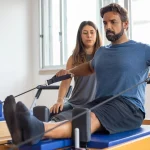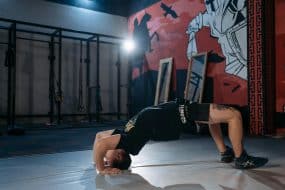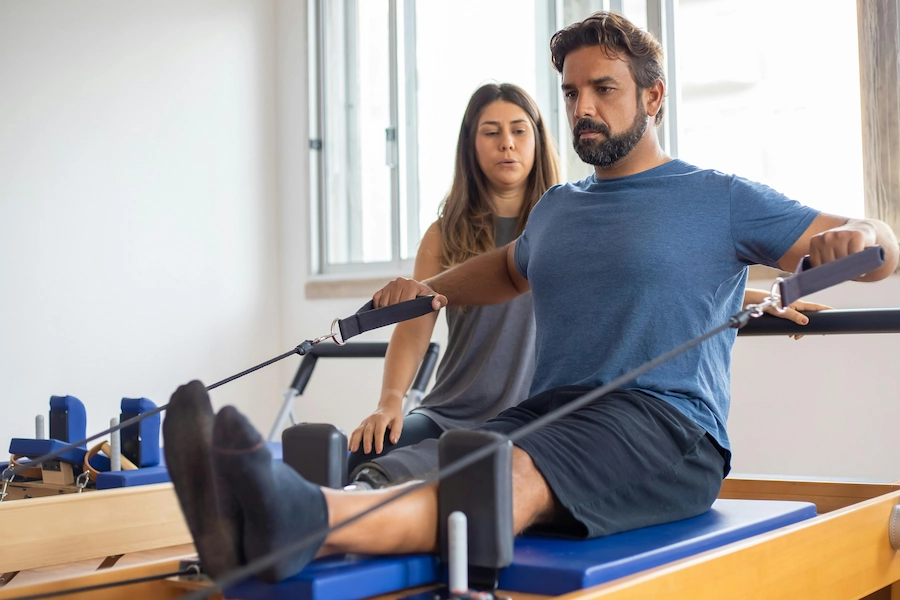
The Secret Weapon of Elite Athletes
When NBA legend LeBron James attributes his 20-year career longevity to Pilates for Athletes, and Olympic icon Michael Phelps uses it to maintain the flexibility required for record-breaking swims, it’s clear this century-old practice isn’t just for dancers. Pilates, developed by Joseph Pilates in the 1920s as a rehabilitation method for injured soldiers, has evolved into a science-backed cornerstone of modern athletic training. Its emphasis on controlled movements, breathwork, and alignment makes it uniquely suited to address the physical and mental demands of competitive sports.
For athletes, Pilates is more than a workout—it’s a precision tool. Unlike traditional weightlifting or cardio, Pilates targets the often-neglected stabilizing muscles that form the foundation of explosive power, agility, and endurance. Whether you’re a sprinter seeking milliseconds off your time, a weightlifter aiming to protect your spine under heavy loads, or a basketball player recovering from a grueling season, Pilates offers a customizable path to peak performance. Let’s explore why athletes worldwide are swapping generic cross-training for Pilates for Athletes—and how you can harness its benefits to outlast, outthink, and outperform the competition.
Why Athletes Need Pilates?
1. The Engine of Athletic Power
Your core isn’t just your abs—it’s a complex network of muscles (transverse abdominis, pelvic floor, obliques) that stabilize your spine and transfer force between your upper and lower body. Consider the rotational power of a golfer’s drive or the explosive takeoff of a high jumper: both rely on a strong, responsive core to channel energy efficiently. A 2022 study in Sports Medicine found that athletes who practiced Pilates for Athletes reduced lower back injuries by 42% and improved power output by 18% compared to those who focused solely on traditional strength training.
Pilates shines here because it trains the core in functional, multiplanar movements rather than isolating muscles in rigid patterns. For example, the “Teaser” exercise challenges athletes to maintain spinal alignment while transitioning between positions, mimicking the dynamic stability required during a tennis serve or a soccer kick.
2. Injury Prevention: Science-Backed Protection
Pilates for Athletes targets muscle imbalances that lead to chronic injuries. Take soccer players, for instance: the repetitive kicking motion often overdevelops the quadriceps while weakening the hamstrings, creating a dangerous imbalance that predisposes athletes to ACL tears. A landmark study in the Journal of Sports Science & Medicine found that a 12-week Pilates program reduced ACL injuries in female soccer players by 31% by restoring hamstring-quadriceps balance and improving neuromuscular control. Similarly, runners plagued by IT band syndrome often find relief through Pilates exercises like the “Clam Shell,” which corrects pelvic tilt and strengthens the gluteus medius—a common weak link in endurance athletes.
3. Mobility That Translates to Performance
Static stretching has its place, but Pilates for Athletes takes mobility to the next level by combining elongation with strength. Take the “Swan Dive,” for example: this exercise stretches the hip flexors and chest while simultaneously strengthening the spinal erectors and glutes. For cyclists, who spend hours hunched over handlebars, Pilates counteracts tight hip flexors and rounded shoulders, restoring the posture needed for efficient pedal strokes. Gymnasts, meanwhile, use Pilates to improve shoulder mobility for maneuvers on the rings or uneven bars, where a single degree of extra range can mean the difference between sticking a landing or faltering.
4. Mind-Body Connection: The Hidden Edge
Pilates for Athletes demands intense focus on breath and movement quality, sharpening the mind-body connection in ways that translate directly to competition. Rock climbers, for instance, rely on proprioception—the body’s awareness of its position in space—to navigate precarious holds. Pilates exercises like the “Single-Leg Stretch” train this skill by requiring athletes to stabilize their pelvis while moving opposing limbs, a challenge that mirrors the split-second adjustments needed on a climbing wall. This mental discipline also helps athletes stay calm under pressure: a 2021 study in the Journal of Athletic Enhancement found that athletes who practiced Pilates reported 25% lower anxiety levels during high-stakes competitions compared to control groups.
Top 5 Pilates Exercises for Athletes
1. The Hundred
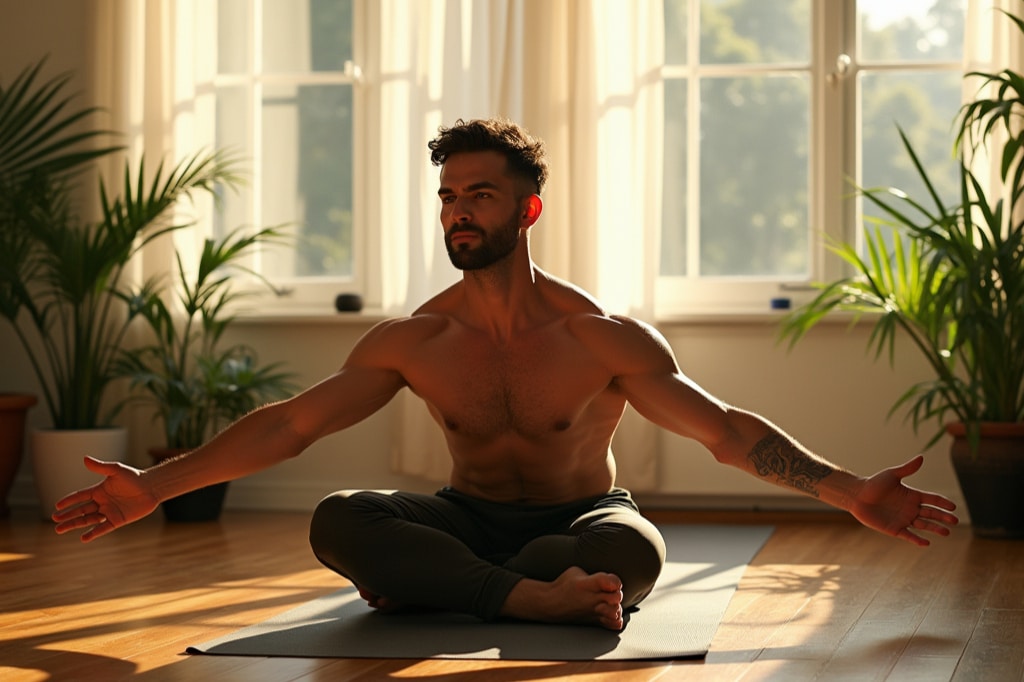
How It Works: Lie on your back with legs in a tabletop position (knees bent at 90 degrees). Lift your head and shoulders off the mat, engaging your deep core muscles as you pump your arms up and down in small, controlled motions. Inhale for five pumps, exhale for five, and repeat for a total of 100 breaths.
Sport-Specific Benefits: This Pilates for Athletes staple is a game-changer for endurance athletes like runners and cyclists. The rhythmic breathing pattern enhances respiratory endurance, teaching athletes to maintain oxygen efficiency during long efforts. For swimmers, it builds the ribcage mobility needed for powerful strokes. Beginners can modify by keeping their knees bent and lowering their head if neck strain occurs, while advanced athletes can straighten their legs to a 45-degree angle for added core engagement.
2. Single-Leg Stretch

How It Works: Lie on your back and draw your right knee toward your chest while extending your left leg at a 45-degree angle. Switch legs in a fluid cycling motion, keeping your pelvis stable and shoulders grounded.
Sport-Specific Benefits: Soccer players and hurdlers benefit from the improved hip mobility this Pilates for Athletes exercise provides, which translates to higher kicks and smoother transitions over barriers. The constant engagement of the transverse abdominis also builds the core stability needed for sudden directional changes on the field. For added intensity, athletes can incorporate ankle weights or perform the exercise on a Pilates reformer with light spring resistance.
3. Swan Dive

How It Works: Lie prone (face down) with hands positioned under your shoulders. Press through your palms to lift your chest and legs off the mat, then gently “rock” forward and backward while maintaining a long spine.
Sport-Specific Benefits: Weightlifters and sprinters use this Pilates for Athletes move to strengthen the posterior chain—the muscles along the backside of the body that drive explosive movements. The Swan Dive doubles as a foundational back bodyweight training, targeting the spinal erectors and hamstrings to help athletes maintain proper form during deadlifts or accelerate explosively out of starting blocks. For those with lower back sensitivity, modifications like reducing the range of motion or placing a folded towel under the hips ensure safe progression.
4. Side Plank with Rotation
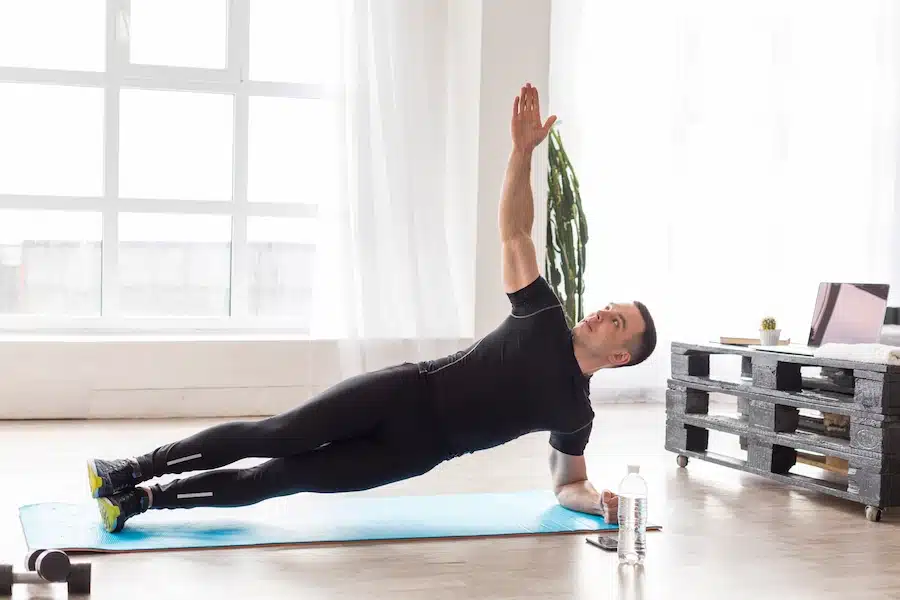
How It Works: Start in a side plank position with your bottom elbow directly under your shoulder and your top arm extended toward the ceiling. Rotate your torso to thread your top arm under your ribcage, then return to the starting position.
Sport-Specific Benefits: This Pilates for Athletes exercise is a secret weapon for baseball pitchers, golfers, and tennis players who rely on rotational power. By engaging the obliques and serratus anterior, it builds the torque needed for a 90-mph fastball or a 300-yard drive. Athletes recovering from shoulder injuries can modify by performing the rotation on their knees, while advanced practitioners can add a resistance band around their wrists for increased challenge.
5. Teaser

How It Works: Sit with your legs extended in front of you and arms parallel to your thighs. Roll your spine back into a “C” shape, then engage your core to lift into a balanced “V” position.
Sport-Specific Benefits: Divers, gymnasts, and figure skaters use this Pilates for Athletes staple to enhance mid-air control and body awareness. The exercise demands precise coordination between the deep core and hip flexors, mimicking the stability required during a backflip or a triple axel. Beginners can bend their knees or use a resistance band looped around their feet for support, while elite athletes can challenge themselves by holding the “V” position for 10-second intervals.
Sport-Specific Pilates Routines
Endurance Athletes (Runners/Cyclists)
Endurance sports demand repetitive motion patterns that often lead to muscular imbalances. A runner’s Pilates for Athletes routine might focus on releasing tight hip flexors through exercises like the “Knee Stretch Series” on the Pilates reformer, which combines dynamic stretching with resistance to improve stride length. Cyclists, meanwhile, benefit from the “Spine Corrector,” a Pilates apparatus that opens the chest and counteracts the forward-leaning posture common in cycling. A sample 30-minute Pilates session could include:
- Hip Circles on the Reformer: 3 sets of 8 repetitions per side to improve hip mobility.
- Spine Stretch Forward: 3 sets of 10 repetitions to decompress the lower back.
- Footwork Series: 5 minutes of pointed/flexed foot movements to strengthen calf muscles and prevent Achilles tendinitis.
Strength Athletes (Weightlifters/Powerlifters)
Heavy lifting places immense stress on the joints and connective tissues. Pilates for Athletes exercises like the “Chest Expansion” on the Cadillac machine build scapular stability, protecting the shoulders during overhead presses. The “Mermaid Stretch” addresses thoracic spine stiffness, allowing for deeper squats and safer barbell positioning. A pre-lift Pilates warm-up might include:
- Pelvic Curls: 2 sets of 15 reps to activate the glutes and hamstrings.
- Shoulder Bridge with Marching: 3 sets of 10 reps per leg to engage the core before deadlifts.
Team Sports (Basketball/Football)
Team athletes need explosive lateral movement and rapid deceleration. The “Side Splits” exercise on the Pilates chair builds adductor and abductor strength for sharp cuts on the court or field. Meanwhile, the “Jump Board” attachment on the reformer allows basketball players to practice plyometric jumps with reduced joint impact. A post-game Pilates for Athletes recovery session might focus on:
- Leg Springs Series: 10 minutes of controlled leg movements to flush lactic acid.
- Ribcage Arms: 5 minutes of shoulder rotations to counteract the hunched posture common in contact sports.
Integrating Pilates for Athletes into Training Cycles
Pre-Season: Building Resilience
During pre-season, athletes should prioritize injury prevention and foundational strength. Aim for 2-3 Pilates sessions per week, focusing on exercises that address sport-specific vulnerabilities. A basketball player, for example, might emphasize ankle stability with “Footwork on the Reformer,” while a swimmer could target shoulder mobility with “Arm Circles on the Cadillac.”
In-Season: Maintenance and Recovery
The competitive season demands efficiency. A 20-minute mat Pilates for Athletes routine performed once weekly can maintain gains without overtaxing the body. Exercises like “Rolling Like a Ball” massage the spine and improve circulation, while “Side-Lying Leg Lifts” keep the hip abductors engaged between games.
Post-Season: Restoring Balance
After months of repetitive strain, Pilates for Athletes becomes a tool for restoration. Focus on gentle flows that release tension, such as the “Saw” exercise for rotational mobility or the “Neck Pull” to alleviate cervical spine stiffness. Many athletes pair this phase with yoga or massage therapy for holistic recovery.
From Sideline to Starting Lineup
Athlete: Marcus Carter, NFL Linebacker
Challenge: Chronic hamstring strains limited Carter to 8 games per season, jeopardizing his career. Traditional physical therapy provided temporary relief, but imbalances persisted.
Pilates Program:
- Phase 1 (Weeks 1-4): Twice-weekly sessions focusing on posterior chain activation. Key exercises included the “Leg Pull Front” (to strengthen hamstrings) and the “Long Spine Stretch” (to release lumbar tension).
- Phase 2 (Weeks 5-12): Incorporation of the Pilates reformer for dynamic resistance. The “Jump Board” series improved explosive power, while “Elephant on the Tower” enhanced calf flexibility for faster sprints.
Results: - 30% reduction in hamstring injuries over two seasons.
- 40-yard dash time improved from 4.65 to 4.52 seconds.
- Increased tackle efficiency due to better lateral mobility.
Common Mistakes Athletes Make with Pilates
1. Overtraining
While Pilate is low-impact, daily sessions can overwork stabilizer muscles, leading to diminished returns. NFL trainer Dr. Laura Simmons recommends limiting Pilates for Athletes to 3-4 times weekly, alternating with active recovery days.
2. Neglecting Equipment
Many athletes stick to mat Pilates, missing out on the resistance and versatility of apparatus like the reformer or Cadillac. For example, hockey players can use the “Trapeze Table” to simulate stick-handling motions with controlled resistance.
3. Sacrificing Form for Intensity
Pilates for Athletes rewards precision, not power. Arching the neck during the “Roll-Up” or rushing through the “Single-Leg Stretch” reduces effectiveness and increases injury risk. Always prioritize quality over quantity.
FAQs
- Q: Can Pilates for Athletes replace weight training?
A: No—it complements it. Pilate builds the stability and mobility needed to lift safely, while weight training develops raw strength. Think of Pilate as the architect and the weights as the construction crew. - Q: How soon will I see performance improvements?
A: Most athletes notice better posture and reduced soreness within 2-3 weeks. Measurable gains in power or flexibility typically emerge after 4-6 weeks of consistent Pilates for Athletes practice. - Q: Mat vs. Reformer Pilates?
A: Start with mat Pilates to master bodyweight control, then progress to the reformer for sport-specific resistance. The reformer’s adjustable springs are ideal for mimicking movements like a tennis serve or a swim stroke.
Elevate Your Game with Pilates for Athletes
Pilates for Athletes isn’t about perfecting poses—it’s about refining the movements that make you unstoppable in your sport. Whether you’re rehabbing an injury, preparing for a championship, or seeking longevity in a grueling career, Pilates offers a roadmap to sustainable success.
Your Challenge: For the next two weeks, incorporate the “Single-Leg Stretch” into your warm-up routine. Pay attention to how your hips feel during lunges, kicks, or sprints. Notice the difference in stability and range of motion.
As Joseph Pilates famously said, “In 10 sessions, you’ll feel the difference. In 20, you’ll see it. In 30, you’ll have a new body.” For athletes, that “new body” isn’t just stronger—it’s smarter, more resilient, and finely tuned for the demands of your sport.



